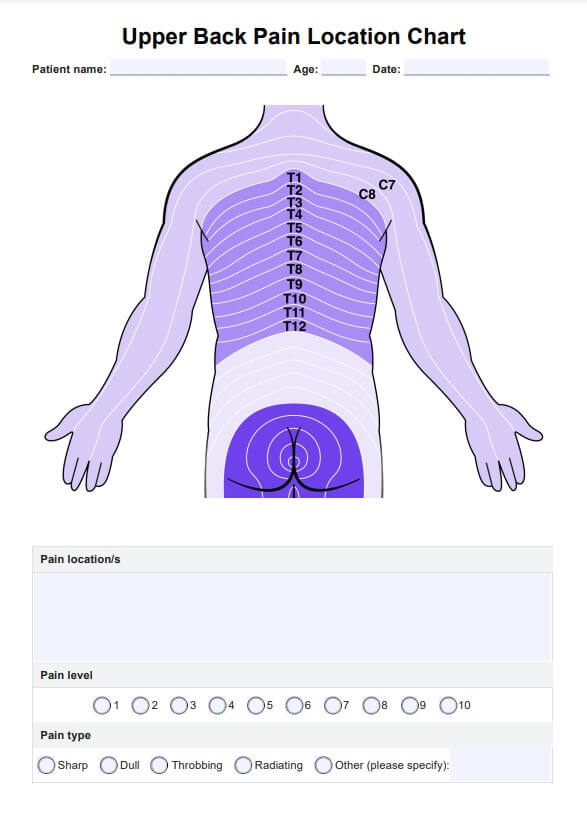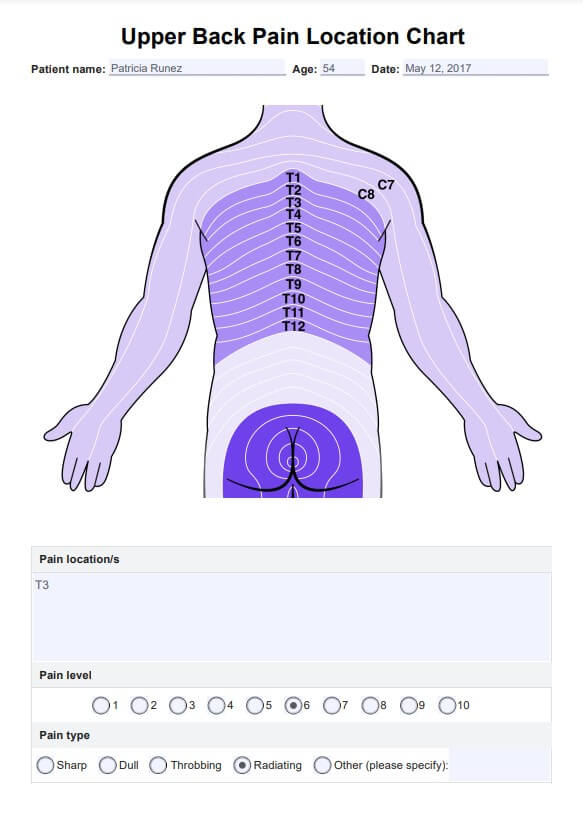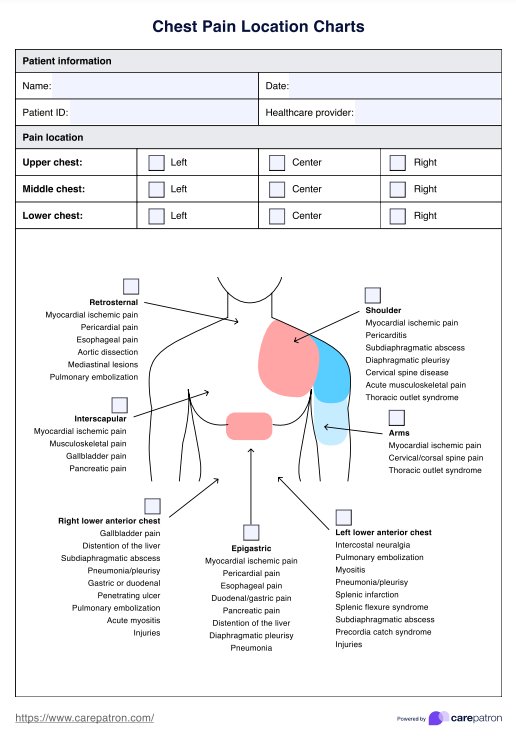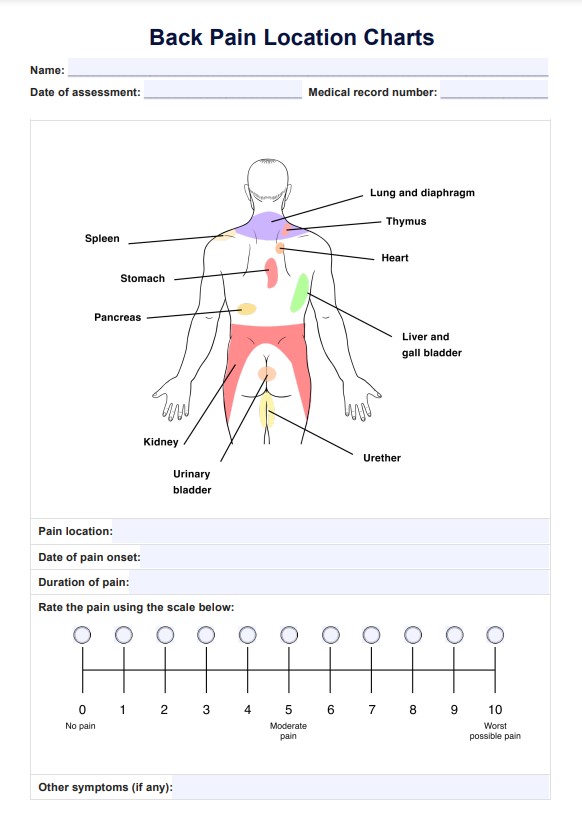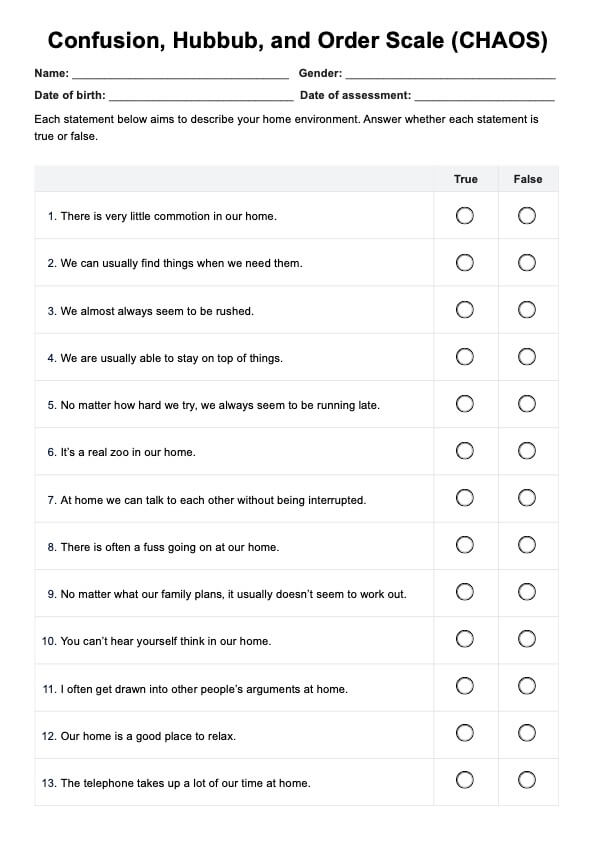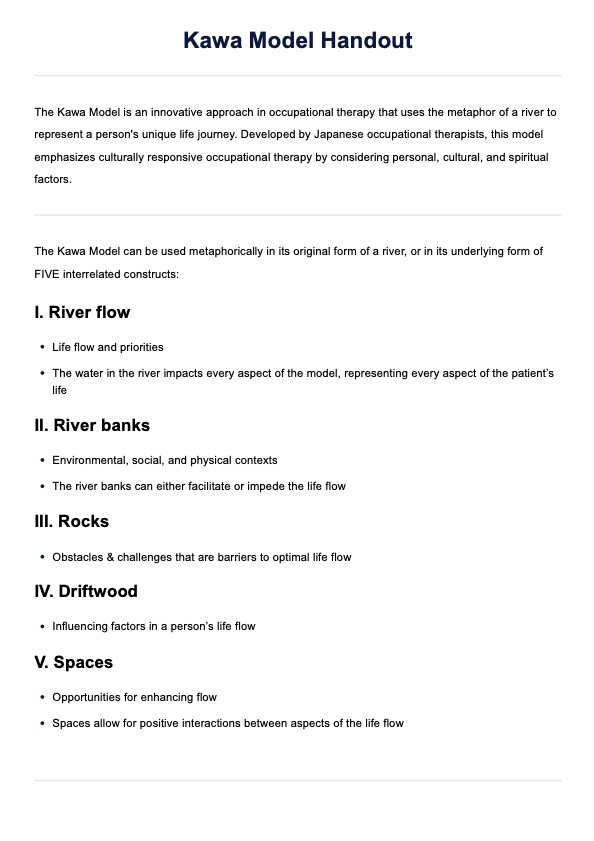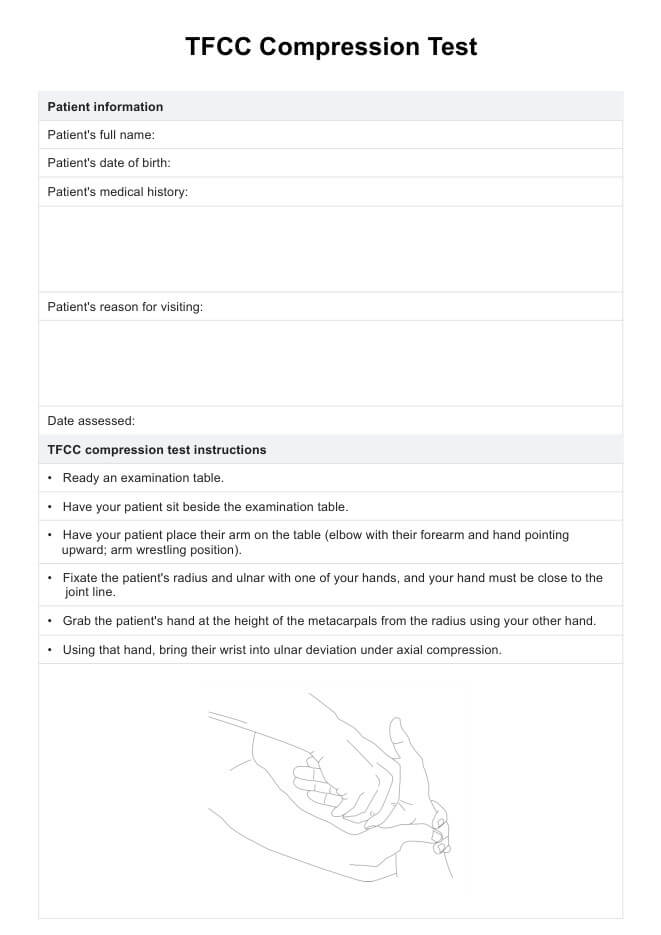Upper Back Pain Location Chart
Better understand and diagnose your patient’s condition with an Upper Back Pain Location Chart. Click here for more information and a template copy.


What is an Upper Back Pain Location Chart?
An Upper Back Pain Location Chart is a visual representation of the different areas in the upper back where an individual may experience pain. It typically includes a diagram of the back with various sections labeled.
An Upper Back Pain Location Chart can help healthcare professionals identify the specific area of their patients' back where they are experiencing pain. This can be valuable in diagnosing the cause of the pain and creating a targeted treatment plan.
This chart can also be useful for individuals who are experiencing upper back pain, as it allows them to pinpoint the exact location of their pain and communicate it more effectively to their healthcare provider.
Upper Back Pain Location Chart Template
Upper Back Pain Location Chart Example
How to use our Upper Back Pain Location Chart
Carepatron's Upper Back Pain Location Chart includes a diagram with a dermatome map of the thoracic spine labeled from T1 to T12 and the base of the neck, labelled C7 and C8. Here's how to use the template for easy clinical documentation:
Step 1. Access and download the template
To obtain a digital and printable version of the Upper Back Pain Location Chart template, Click the "Use Template" or "Download" button. You can also search for "Upper Back Pain Location Chart" in Carepatron's template library using the app or website's search bar.
Step 2: Use during assessment
Ask your patient to point to the specific area of their upper back where they are experiencing pain and compare it with the diagram in the Upper Back Pain Location Chart. This step will help you identify the exact location of the pain and document it accurately.
Step 3: Add notes
Use the template's "Additional notes" section to document any additional information provided by the patient, such as the type of pain (sharp pain, dull pain, throbbing pain, radiating pain), when it started, and any triggers or aggravating factors.
Step 4: Assess the patient based on the location
Once the patient has pinpointed the location of the pain, do relevant tests to rule out or diagnose issues that affect the pinpointed area. You may do physical tests, provocative tests, or even imaging. As the healthcare provider, you will know best what tests need to be done.
Step 5: Make a plan
Based on the information gathered from the template and discussion with your patient, develop an appropriate treatment plan. This could include medication, lifestyle changes, physical therapy, maintaining a healthy weight to alleviate pain, or even surgical intervention.
Step 6: Collaborate with other healthcare professionals
If needed, share the Upper Back Pain Location Chart with other healthcare professionals involved in the care of your patient. This will visually represent the pain location and aid in effective communication between healthcare providers.
When would you use this chart?
An Upper Back Pain Location Chart can be used in various healthcare settings, including:
Primary care
During a routine physical examination, a patient may report upper back pain. The Upper Back Pain Location Chart can be used to document the specific location and any accompanying notes.
Physical therapy or chiropractic care
In these settings, the chart can be used to track changes in pain location and intensity over time, as well as guide treatment plans. A physical therapist or a chiropractor can also use the chart to communicate with other healthcare professionals involved in the patient's care.
Emergency room or urgent care
In cases of acute or chronic back pain, the Upper Back Pain Location Chart can be used as part of the initial assessment, allowing for a quick and accurate documentation of the pain location for further evaluation.
Upper back pain vs other types of back pain
Upper back pain is often confused with other types of back pain, such as lower back or neck pain. However, there are key differences between these types of pain that can help identify and diagnose the root cause:
Location of pain
As mentioned, upper back pain refers to discomfort in the area between the base of the neck and the bottom of the ribcage. This region can be affected by injury, poor posture, or muscle strain.
Lower back pain or chronic low back pain, on the other hand, is felt in the lumbar spine region and is much more common due to the stress this area endures. This pain can radiate down the legs, especially when it involves nerve impingement. Meanwhile, neck pain, which may coexist with upper back discomfort, affects the cervical spine and often results in limited head movement.
Causes
Upper back pain is typically caused by muscular irritation or joint dysfunction. Factors like poor posture, carrying heavy backpacks, or sitting for long periods can exacerbate it. Chronic low back pain often stems from spinal cord issues such as disc herniation, arthritis, or degenerative disc disease. This pain is more likely to become chronic, lasting for weeks or even months. However, note that chronic pain in any region of the back may also result from underlying conditions like fibromyalgia or previous injuries.
Symptoms
Upper back pain symptoms may include a dull ache or sharp pain. The pain worsens as there is a lot of movement or pressure on the affected area. Some people report a sensation of tightness or stiffness in the upper body. In severe cases, it can also cause difficulty breathing.
Chronic back pain symptoms in the lower back are often more severe, with pain worsening after prolonged periods of inactivity or sudden movements. In cases of back or neck pain, patients may experience pain that radiates into the arms or legs, tingling, numbness, or even muscle weakness.
Commonly asked questions
You can identify your back pain by analyzing the location, type of pain and any accompanying symptoms. The type of pain can range from a dull ache to sharp and stabbing. Other symptoms such as tingling, numbness, or weakness in the legs may indicate nerve involvement. Consult a doctor for a proper diagnosis and treatment plan.
Organ-related back pain is usually characterized by a constant, dull ache in the upper or lower back. It can also be accompanied by other symptoms such as fever, nausea, and vomiting. If you are experiencing these symptoms in addition to your back pain, it is important to see a doctor for proper evaluation and treatment.
Muscular back pain is often caused by strain or injury to the back muscles and can be identified by a sharp or throbbing pain that worsens with movement. It may also be accompanied by stiffness and soreness in the affected area.


